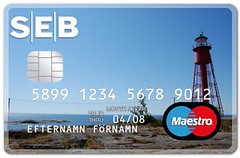Consumers today are more individualistic than previous generations and that’s one reason why you see teenagers (and we who think we still are) pimp their mobile phones and iPods to get that unique look. Who wants to look like everyone else? While some may argue that people are individualistic in pretty much the same way, facts remain, consumers are spending more and more money on customizing everything from Xbox 360 consoles to sneakers.
With such a demand among consumers, many companies could differentiate themselves against competitors by offering so-called mass customization solutions that enable each customer to tailor a product with a unique design. A recent example are Swedish banks that have started to promote personalized payment cards. Their customers can upload a picture of their choice on the bank’s website (or choose one from an online gallery) to design a unique personal credit card.
 Swedbank was the first Swedish bank to offer personalized payment cards when they launched Kort på Kort (Photo on Card) a year ago. A little odd though that it initially was limited to grown ups! One would have guessed it to be the other way around, considering the motivations of the different age groups. The cost is 100 kronor for a new card.
Swedbank was the first Swedish bank to offer personalized payment cards when they launched Kort på Kort (Photo on Card) a year ago. A little odd though that it initially was limited to grown ups! One would have guessed it to be the other way around, considering the motivations of the different age groups. The cost is 100 kronor for a new card.
Handelsbanken and SEB seem to be using Gemalto’s CardLikeMe, an external web service which offers some flexibility when it comes to adjusting the photo. Handelsbanken charges 123 kronor (and 85 kronor for renewal card) while SEB charges 95 kronor.


From what I can see, the fourth large Swedish bank Nordea doesn’t offer personalized payment cards in Sweden, but they do in Finland, also via CardLikeMe. This of course makes Nordea look dull and uncool in comparison to the other big three.
Banks are not known for giving you something for nothing and since most of them buy the service from an outside supplier one shouldn’t expect this service to be free. We also know that consumers often are willing to pay a price premium for customization, so the strategy may be right. But in a more competetive market there might be room for a smaller player to include personalization without cost in order to present a more attractive offer to new customers.
Advantages of mass customization are many. In the case of personalized payment cards, you will increase customer loyalty because the customer is more likely to stay with the bank to be able to use the same card (renewal is often free). You get a higher degree of involvement with the product because the card user will be proud to display the unique card and therefore inclined to use it more often (vs. cash). It is also a source of additional revenue for the bank since the cost for a unique card is higher than for the ‘plain vanilla’ version.
Expect to see more companies offer customization solutions as printing technology and other means of production evolve. What really boring products would you like to pimp?
Tags: banks, customization, banker, swedbank, pengar, seb. Ping.